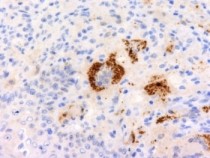ARG56080
anti-TNF alpha antibody [P/T2]
anti-TNF alpha antibody [P/T2] for Flow cytometry,ICC/IF,IHC-Formalin-fixed paraffin-embedded sections and Human,Mouse
概述
| 产品描述 | Mouse Monoclonal antibody [P/T2] recognizes TNF alpha |
|---|---|
| 反应物种 | Hu, Ms |
| 应用 | FACS, ICC/IF, IHC-P |
| 宿主 | Mouse |
| 克隆 | Monoclonal |
| 克隆号 | P/T2 |
| 同位型 | IgM, kappa |
| 靶点名称 | TNF alpha |
| 抗原物种 | Human |
| 抗原 | Synthetic peptide around aa. 115-130 (NGVELRDNQLVVPSEG) of Human TNF alpha protein. |
| 偶联标记 | Un-conjugated |
| 別名 | Tumor necrosis factor ligand superfamily member 2; DIF; Cachectin; ICD2; ICD1; N-terminal fragment; TNF-a; TNFA; TNFSF2; TNF-alpha; Tumor necrosis factor; NTF |
应用说明
| 应用建议 |
|
||||||||
|---|---|---|---|---|---|---|---|---|---|
| 应用说明 | Antigen retrieval for IHC-P: Staining of formalin-fixed tissues requires boiling tissue sections in 10mM Tris buffer with 1mM EDTA, pH 9.0, for 10-20 min followed by cooling at RT for 20 min. * The dilutions indicate recommended starting dilutions and the optimal dilutions or concentrations should be determined by the scientist. |
属性
| 形式 | Liquid |
|---|---|
| 纯化 | PEG precipitation |
| 缓冲液 | PBS (pH 7.4), 0.05% Sodium azide and 0.1 mg/ml BSA |
| 抗菌剂 | 0.05% Sodium azide |
| 稳定剂 | 0.1 mg/ml BSA |
| 浓度 | 0.2 mg/ml |
| 存放说明 | For continuous use, store undiluted antibody at 2-8°C for up to a week. For long-term storage, aliquot and store at -20°C or below. Storage in frost free freezers is not recommended. Avoid repeated freeze/thaw cycles. Suggest spin the vial prior to opening. The antibody solution should be gently mixed before use. |
| 注意事项 | For laboratory research only, not for drug, diagnostic or other use. |
生物信息
| 数据库连接 | |
|---|---|
| 基因名称 | TNF |
| 全名 | tumor necrosis factor |
| 背景介绍 | This gene encodes a multifunctional proinflammatory cytokine that belongs to the tumor necrosis factor (TNF) superfamily. This cytokine is mainly secreted by macrophages. It can bind to, and thus functions through its receptors TNFRSF1A/TNFR1 and TNFRSF1B/TNFBR. This cytokine is involved in the regulation of a wide spectrum of biological processes including cell proliferation, differentiation, apoptosis, lipid metabolism, and coagulation. This cytokine has been implicated in a variety of diseases, including autoimmune diseases, insulin resistance, and cancer. Knockout studies in mice also suggested the neuroprotective function of this cytokine. [provided by RefSeq, Jul 2008] |
| 生物功能 | Cytokine that binds to TNFRSF1A/TNFR1 and TNFRSF1B/TNFBR. It is mainly secreted by macrophages and can induce cell death of certain tumor cell lines. It is potent pyrogen causing fever by direct action or by stimulation of interleukin-1 secretion and is implicated in the induction of cachexia, Under certain conditions it can stimulate cell proliferation and induce cell differentiation. Impairs regulatory T-cells (Treg) function in individuals with rheumatoid arthritis via FOXP3 dephosphorylation. Upregulates the expression of protein phosphatase 1 (PP1), which dephosphorylates the key 'Ser-418' residue of FOXP3, thereby inactivating FOXP3 and rendering Treg cells functionally defective. Key mediator of cell death in the anticancer action of BCG-stimulated neutrophils in combination with DIABLO/SMAC mimetic in the RT4v6 bladder cancer cell line. The TNF intracellular domain (ICD) form induces IL12 production in dendritic cells. [UniProt] |
| 细胞定位 | Cytoplasmic and extracellular (secreted) |
| 产品亮点 | Related products: TNF alpha antibodies; TNF alpha ELISA Kits; TNF alpha Duos / Panels; TNF alpha recombinant proteins; Anti-Mouse IgM secondary antibodies; Related news: HMGB1 in inflammation Inflammatory Cytokines |
| 预测分子量 | 26 kDa |
| 翻译后修饰 | The soluble form derives from the membrane form by proteolytic processing. The membrane-bound form is further proteolytically processed by SPPL2A or SPPL2B through regulated intramembrane proteolysis producing TNF intracellular domains (ICD1 and ICD2) released in the cytosol and TNF C-domain 1 and C-domain 2 secreted into the extracellular space. The membrane form, but not the soluble form, is phosphorylated on serine residues. Dephosphorylation of the membrane form occurs by binding to soluble TNFRSF1A/TNFR1. O-glycosylated; glycans contain galactose, N-acetylgalactosamine and N-acetylneuraminic acid. |
检测图片 (2) Click the Picture to Zoom In
-
ARG56080 anti-TNF alpha antibody [P/T2] IHC-P image
Immunohistochemistry: Mouse vertebral stained with ARG56080 anti-TNF alpha antibody [P/T2].
From Kaiao Zou et al. J Inflamm Res. (2023), doi: 10.2147/JIR.S439981, Fig. 5B.
-
ARG56080 anti-TNF alpha antibody [P/T2] IHC-P image
Immunohistochemistry: Formalin-fixed, paraffin-embedded Human Erdheim Chester disease (polyostotic sclerosing histiocytosis) stained with ARG56080 anti-TNF alpha antibody [P/T2].
文献引用









